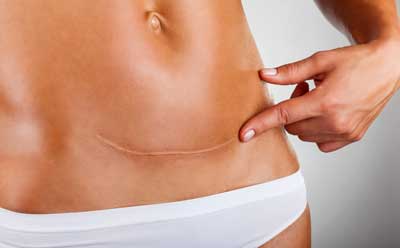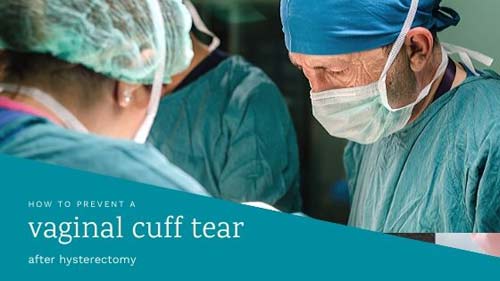The benefits of wearing an abdominal binder after hysterectomy surgery
This blog is reader-supported. When you buy through a link on our site, we earn a commission at no extra cost to you. Read more
Should you wear an abdominal binder after hysterectomy? When you are scheduled to have a hysterectomy, you may want to discuss with your doctor if it is okay to wear an abdominal binder after surgery.

After a hysterectomy, managing postoperative pain is a crucial part of recovery, and a support belt or abdominal binder can help reduce a lot of the discomfort caused by the surgery.
What is an Abdominal Binder?
An abdominal binder is a wide compression body garment women can wear in the early postoperative days. Usually, they are made of soft elastic material and provide even circumferential compression on the abdomen. They come in different sizes because the right measurements are important for a comfortable fit.
What are the benefits of an abdominal binder after hysterectomy?
You may be wondering, what is the purpose of wearing an abdominal binder? For one thing, wearing an abdominal binder after hysterectomy may help speed up your recovery.
After surgery, normal physical activities can be very painful in the beginning because of the extra pressure it puts on your incision. Many women feel more comfortable wearing an abdominal binder after a hysterectomy, as it supports the wound and makes moving around less painful.
How may an abdominal binder help?
- Support your incision. Applying steady pressure can prevent the excessive formation of scar tissue.
- Less pain with daily activities (walking, getting out of bed).
- Decrease abdominal swelling at the surgical site.
- Prevents lung complications (making coughing and deep breathing less painful)
Abdominal binders aid early activity after a hysterectomy, so they can help prevent pneumonia and reduce the risk of blood clots and DVT.
How long should you wear an abdominal binder after hysterectomy surgery?
The average time women wear an abdominal binder is from 6 to 8 weeks. However, your surgeon is the best person to ask about the length of time and whether wearing a binder is beneficial in your situation.
A lot depends on the type of hysterectomy they performed. Moreover, it may be useful to ask how many hours a day you need to wear the abdominal binder; some surgeons recommend wearing it only during the day.
Is it safe to wear an abdominal binder after hysterectomy?
More extensive studies are necessary to assess their safety correctly and if binder use can reduce the risk of complications.
Some possible negative effects identified in a 2016 study include reduced blood supply to the wound, pressure on surgical drains, weakening of the muscles, increased intra-abdominal pressure, and an increased risk of DVT.
However, enough evidence supports the advantages of wearing abdominal binders, such as improved early mobilization, overall comfort, and better pain control.
Furthermore, the greatest risk factor of DVT after surgery is inactivity and staying too much in bed. Thus, the advantages of wearing an abdominal binder may outweigh the risks in this case.
How to wear an abdominal binder?
Most abdominal binders are very straightforward to use. Simply wrap the garment around the abdomen under your clothes and fasten it with the velcro straps. Above all, make sure the binder is not too tight.
When you have difficulties breathing, moving around, or going to the bathroom, loosen the garment until you get a comfortable fit. When you have a surgical drain after surgery, make sure there is not too much pressure on it and the fluids can run off properly.
Where to purchase an abdominal binder?
Your doctor will be able to tell you what type of binder you need for your type of hysterectomy surgery. And with a prescription, you may be able to get the money back from your medical insurance.
You can buy abdominal binders online or at your local drugstore. Most important, you have to get the right size. With a tape measure, find the widest part the binder is supposed to cover.
A good example is the PAZ WEAN abdominal binder for hysterectomy recovery, which comes in 3 sizes for women and is made of high-quality, breathable elastic material. However, many women prefer to wear the Upspring C-panty Recovery Underwear, specially designed for women having a C-section or abdominal hysterectomy.
Some of the benefits of the post-op recovery underware over the traditional binder are that it’s not as bulky thus, less visible under the clothes. It covers the abdomen from the bra line to the hips and makes sure your incision is supported and protected.
How to care for the binder?
From time to time, you will have to clean the garment as it may get dirty from sweating or from wound drainage. A dirty binder may increase your risk of infection, so you must keep it clean. For this reason, many women buy two binders always to have a clean one.
In order to maintain the quality and compression of the binder, you should clean it as per the manufacturer’s instructions. Most compression garments should not be washed in the machine, but hand washed in lukewarm water and hung to dry.
In conclusion
More extensive research is needed to confirm the benefits of wearing an abdominal binder after hysterectomy and whether they can reduce postoperative complications such as hernia, infections, and wound dehiscence.
However, several small studies show us that abdominal binders can help stabilize the abdominal wound when patients need to sneeze, get out of bed, or strain to have a bowel movement. This means that in the post-hysterectomy recovery period an abdominal binder may reduce pain during daily activities as well as give women a sense of security.
References
- The Effect of Abdominal Support on Functional Outcomes in Patients Following Major Abdominal Surgery: A Randomized Controlled Trial
- Clinical evidence for using abdominal binders and a radical new design to make them more effective
Related posts
- The Undeniable Benefits of a Hysterectomy
- Hysterectomy Preparation Checklist
- Embracing Robot-Assisted Precision: Da Vinci Robotic Hysterectomy for a Smoother Recovery








I don’t have an abdominal binder, but as an old distance runner, I’m used to taping injuries for extra support, so two days after my surgery (LAVH-BSO on 6/6/2019), I rustled up a wide Ace bandage I’d bought to deal with a karate injury 20 years ago, wrapped my lower abdomen as I would a knee or ankle, and promptly dropped my pain level from a 7 or 8 to a solid 3 without opioids (which I can’t keep down). I wore the bandage almost constantly for two or three days, then took it off and used it only when I was going for a walk or felt like I needed some extra support. It was extremely helpful. Bonus: If you have a couple of those little flat ice packs that are designed to keep bento boxes cool, you can wrap one in a washcloth and tuck it inside the bandage to keep the swelling down. At this point, I don’t need the bandage at all, though I’ll probably break it out again when it’s time for the road trip I’m planning to take in a couple of weeks.